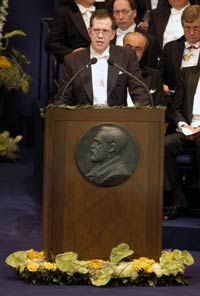Award ceremony speech
Presentation Speech by Professor Urban Lendahl of the Nobel Committee at Karolinska Institutet, December 10, 2002.
Translation of the Swedish text.

Copyright © Nobel Media AB 2002
Photo: Hans Mehlin
Your Majesties, Your Royal Highnesses, Ladies and Gentlemen,
We have all begun our lives in a seemingly modest way – as the fertilised egg cell, a tenth of a millimetre in size. From this small cell, the adult human being develops, with its hundred thousand billion cells, through cell division, cell differentiation and by formation of the various organs. To only make new cells is however not sufficient, certain cells must also die at specific time points as a natural part of the growth process. Think for example about how we for a short period during foetal life have web between our fingers and toes, and how this is removed by cell death.
The importance of cell differentiation and organ development was understood by many, but progress was slow. This was largely an effect of our complexity, with the large number of cells and many cell types – the forest could not be seen because of all the trees. Could the task to find the genetic principles be made simpler? Were there a species simpler than humans, but still sufficiently complex to allow for general principles to be deduced?
Sydney Brenner in Cambridge, UK, took on the challenge, and his choice was the nematode Caenorhabditis elegans. This may at first seem odd, a spool-shaped approximately 1 millimetre long worm with 959 cells that eats bacteria, but Brenner realised in the early 1960s that it was, what we today would call, “loaded with features”. It was genetically amenable and it was transparent, so that every cell division and differentiation could be directly followed in the worm under the microscope. Brenner demonstrated in 1974 that mutations could be introduced into many genes and visualised as distinct changes in organ formation. Through his visionary work, Brenner created an important research tool. The nematode had made into the inner circle of research.
John Sulston came to Brenner’s laboratory in 1969. He took advantage of that cell divisions could be followed under the microscope and assembled the cell lineage in the worm, showing which cells are siblings, first and second cousins. He found that cell divisions occurred with a very high degree of precision, the cell lineage was identical between different individuals. He also realised that certain cells in the lineage always died at a certain time point. This meant that programmed cell death was not a stochastic process, but rather occurred with a very high degree of precision. During the course of this work Sulston identified the first gene important for the cell death process: nuc-1.
Robert Horvitz came to work with Brenner and Sulston in 1974. Horvitz started a systematic search for genes controlling programmed cell death. He identified the key genes for the cell death process proper. The discovery of these central death genes, ced-3, ced-4 and ced-9, changed the view on programmed cell death from something rather obscure to a process with a strict genetic programme. Horvitz also showed that there are human homologues to the death genes in the worm and that those have corresponding functions – the cell death machinery had deep evolutionary roots.
This year’s Nobel Prize celebrates the Joy of Worms. Brenner’s almost prophetic visions from the early 1960s of the advantages of this model organism have been fulfilled. It has given us new insights into the development of organs and tissues and why specific cells are destined to die. This knowledge has proven valuable, for instance, in understanding how certain viruses and bacteria attack our cells, and how cells die in heart attack and stroke.
Sydney Brenner, Robert Horvitz and John Sulston.
Your discoveries concerning the genetic regulation of organ development and programmed cell death have truly opened new avenues for biological and medical research. On behalf of the Nobel Assembly at Karolinska Institutet I wish to convey to you our warmest congratulations and I ask you to step forward to receive the Nobel Prize from the hands of His Majesty the King.
Nobel Prizes and laureates
Six prizes were awarded for achievements that have conferred the greatest benefit to humankind. The 14 laureates' work and discoveries range from quantum tunnelling to promoting democratic rights.
See them all presented here.
